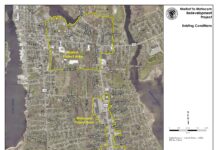Many Rhode Islanders perplexed by the glossy mailings from energy provider North American Power last month, or the company’s television ads, never thought about buying electricity from anyone other than a utility.
In 1996, Rhode Island became the first state to “deregulate” its electricity market, allowing customers to buy electricity from independent providers.
The practice of shopping for power among nonutility providers is well-known to large businesses, but has struggled to take hold in the residential market.
Now companies, including Connecticut-based North American Power and North Kingstown-based First Point Power LLC, are making a push to tap that market.
As of October 2013, the most recent month of data available, 19,800, or 4.1 percent, of the 485,000 homes and businesses served by utility National Grid buy their power from an independent provider. And 10,700 of those buying independently are commercial or industrial users.
But the number of business and residential customers buying independently, while small, has risen slowly and steadily since Rhode Island deregulated power purchase in 1996.
In October 2004, there were 2,900 “competitive supply” customers, a total that rose to 9,800 in 2010 and 17,000 in 2012, all with relatively minimal marketing. And measured by the amount of power sold, instead of number of customers, independent providers now sell a little more than half as much as National Grid.
“Larger users have been doing this for years,” said National Grid spokesman David Graves. “But this is the first time in my memory the option of buying from an alternative marketer has been the subject of a direct mail effort.”
Perhaps more customers in Rhode Island and across the country haven’t been tempted by independent power suppliers because of the complexity of the arrangement.
If they aren’t buying electricity from an independent supplier, almost all power customers buy it from National Grid through what is called the “standard offer.”
That’s because National Grid makes its money transmitting electricity to customers, regardless of whether the utility sells them the electrons being transmitted or not.
When a customer decides to buy power from an independent provider, their electric bill still comes from National Grid and includes a transmission charge for installing and maintaining the wires leading to their home.
Unlike the independent providers, referred to by state officials as nonregulated power producers, National Grid doesn’t look for a profit margin on the energy it sells through the standard offer. It passes through the price it paid for the energy to customers, Graves said, an arrangement enforced by the R.I. Public Utilities Commission, which sets its rates but not those of the nonregulated providers.
So how can the nonregulated providers promise lower prices than National Grid and still make a profit?
Tiffany Eddy, spokeswoman for North American Power, said the company can purchase electricity at a lower price than National Grid by taking advantage of the spot market and entering shorter purchase agreements than the six-month deals the utility uses to maintain stable supply.
Starting in January when the mailings went out, North American Power has guaranteed customers that its rates, fixed or variable, will be lower than National Grid until the end of June, when the standard-offer rates will reset.
Because no one knows how expensive National Grid’s energy will be in the second half of 2014, Eddy said there’s no guarantee that the independent provider will be cheaper long term.
North American Power sells electricity in 11 states and has achieved the deepest penetration in Connecticut, where it has 8 percent of the residential market, Eddy said.
After entering Rhode Island last July, North American Power had signed 5,000 customers, but Eddy said that’s expected to rise as a result of the marketing push.
The nonregulated providers include national companies such as Constellation Energy and about a half dozen Ocean State firms, including First Point, which saw revenue jump from $487,500 in 2010 to $14 million in 2012.
The 5,000 customers North American Power has signed would already place it among the top residential providers, with only one company exceeding that total as of September.
The winter of 2014 may be a good time to pitch Rhode Islanders energy cost-savings plans, as National Grid rates starting in January jumped 35 percent for residential customers and 23.2 percent for commercial customers due to supply constraints on natural gas.
“The timing seemed good for more energy choice in Rhode Island,” Eddy said.
One reason residential users have been reluctant to switch to nonregulated providers, compared to businesses, is the volume of power they use makes savings relatively small relative to the effort required to keep track of a separate power-purchase contract.
On the business side, John Holmes, CEO of Frontline Power Solutions LLC in Bristol, which offers a wide range of energy services to commercial clients, said the bigger focus for companies now is on energy efficiency, demand response (managing when power is consumed) and in many cases generating their own power.
National Grid reports 350 customers in Rhode Island have distributed-generation capacity, meaning they can produce at least some of their own power.
“Businesspeople know they can get a different rate,” Holmes said. “What people don’t know is about demand response, energy efficiency, windmills and solar panels. Solar has jumped big-time since I have been in the industry. It was very expensive and now it is huge.” •
No posts to display
Sign in
Welcome! Log into your account
Forgot your password? Get help
Privacy Policy
Password recovery
Recover your password
A password will be e-mailed to you.












